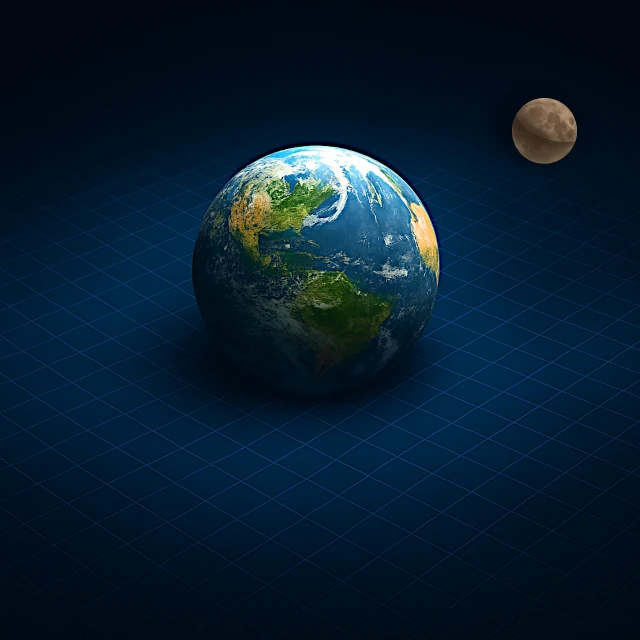
In 1915, Albert Einstein (1879–1955) revolutionized our understanding of gravity with his general relativity. Instead of considering gravity as a mysterious attractive force acting instantaneously at a distance (Newtonian view), Einstein proposed a radically different vision: masses curve the spacetime around them, and this curvature dictates the movement of objects.
According to general relativity, the presence of a mass deforms the surrounding 4D spacetime. Although impossible to represent, Earth's mass creates an extremely weak but measurable deformation.
N.B.:
Spacetime is neither space nor time: it is a unified structure that combines both into a single deformable geometry, whose shape, dictated by matter, determines how everything moves and evolves.
The magnitude of spacetime deformation can be estimated using the equation \(\Delta h \approx \frac{GM}{c^2 r}\), where \(G\) is the gravitational constant, \(M\) is Earth's mass, \(c\) is the speed of light, and \(r\) is the distance considered, for example to the Moon.
This value shows that the curvature at the distance of the Moon is extremely weak, on the order of a few picometers. In other words, \(\Delta h\) corresponds to ≈ 1/10ᵉ the size of an atom.
Spacetime is extremely sensitive, and in the almost perfect vacuum, gravity does not need a large amplitude. A very small deformation of spacetime is enough to influence the trajectory of an object over very long distances.
This tiny "slope" of spacetime causes the Moon to constantly fall toward Earth while allowing it to maintain its tangential speed. This is why gravity acts everywhere and cannot be stopped: it is not a force that can be blocked, but the very geometry of spacetime that guides all movements.
What is the deformation of spacetime for a human being on Earth's surface?
To estimate the deformation of spacetime created by Earth at its surface, we use the same equation \(\Delta h \approx \frac{GM}{c^2 r}\), but this time \(r\) corresponds to Earth's radius, about 6,371 km.
The deformation of spacetime is almost the same for the Moon and for a human being. The quantity that measures the "slope" or "deformation" of the gravitational field is essentially the ratio: \(\frac{GM}{c^2 r}\). The only difference is the distance. The result changes by a factor of ≈ 60, but both values remain extraordinarily small (well below 10-8).
In 4D spacetime, every object follows the trajectory dictated by the curvature (geodesic). The human body naturally follows this orientation, as do all the particles that make it up. At the scale of each atom, the variation in spacetime is \(\Delta h \approx 6.95 \times 10^{-10} \, \text{m}\), about 7 times the size of an atom.
In other words, for each atom, this "slope" is enormous at its scale, as if a hill 7 times our size existed under our feet. Each particle follows exactly this orientation, and the cumulative effect of all particles produces the force we feel as weight.
The effect of spacetime curvature becomes significant when bodies are extremely massive, such as neutron stars, black holes, or galaxies.
| Object | Mass (kg) | Distance considered (m) | Deformation \(\Delta h\) (m) | Comment |
|---|---|---|---|---|
| Atom on Earth's surface | ~ 1.7 × 10-27 | 6.371 × 106 | ~ 6.95 × 10-10 | Huge at the atomic scale, about 7 times the size of an atom; the local slope guides the fall of particles. |
| Human body on Earth's surface | ~ 70 | 6.371 × 106 | ~ 6.95 × 10-10 | Microscopic, but all particles follow the same orientation, producing the felt weight. |
| Earth/Moon | 5.97 × 1024 | 3.84 × 108 (Moon) | 1.15 × 10-11 | Extremely weak curvature, sufficient to guide the Moon in orbit. |
| Sun | 1.99 × 1030 | 1.5 × 1011 (Earth) | 1.48 × 10-6 | Weak deformation but perceptible on the trajectory of planets. |
| Neutron star | ~ 2 × 1030 | 1 × 104 | ~ 0.21 | Absolute value small but curvature is enormous near a neutron star, intense relativistic effects. |
| 10 solar mass black hole | 1.99 × 1031 | 1 × 104 (just above the horizon) | ~ 1.47 | Enormous curvature, capable of trapping light and producing extreme effects. |
| 10 solar mass black hole | 1.99 × 1031 | Center (r → 0) | ∞ | Spacetime curvature diverges at the central singularity; general relativity predicts infinite deformation. |
| Milky Way | ~ 1.5 × 1042 | 5 × 1020 | ~ 2.2 × 10-6 | Extremely weak curvature, but sufficient to influence stellar movements over galactic distances, as it applies to all stars simultaneously. |
| Cluster of 1 million galaxies | ~ 1 × 1048 | 3 × 1024 | ~ 2.5 × 10-4 | Very weak deformation on a cosmic scale, but sufficient to influence the trajectory of galaxies within the cluster. |
Source: Physics Info.
Spacetime is neither space nor time, it is a deformable geometry in four dimensions. Gravity is not a force that can be blocked or shielded: it corresponds to how this entity guides the movement of all matter.
Even the most enormous masses in the Universe create deformations that remain incredibly weak on an absolute scale. Yet, these microscopic "slopes" simultaneously orient every particle, whether in the human body, around a planet, or within a galaxy.
Twisting spacetime is therefore extraordinarily difficult: it requires gigantic masses or extreme conditions to produce a perceptible curvature. This intrinsic resistance reveals how spacetime is a subtle entity, rigid in its geometry and yet universally influential.